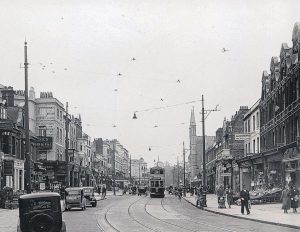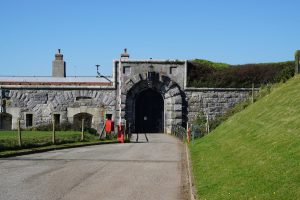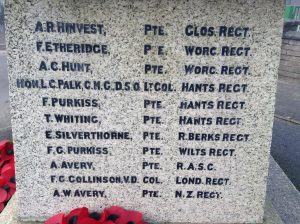Regiment: 10th Battalion, Worcestershire Regiment
Service Number: 36445
Date & place of birth: 4 August 1876 at Teddington, Middlesex
Date & place of death: 17 October 1917, aged 41, at Outtersteene, Departement du Nord, France
Cecil Hunt was a wine merchant by trade. He enlisted aged 40 and died of wounds a year later.
Family background
Arthur Cecil Hunt (known as Cecil) was born at Broad Street, Teddington, Middlesex on 4 August 1876, the oldest son of Arthur Thomas Hunt (1845–1930) and his wife Kate (1842–1918).
Arthur Thomas Hunt was born in Southampton in May 1845. His father, also Arthur, gave his occupation variously as store keeper and stable man. Arthur Thomas married Kate Crampton Hunt at St Mary’s Church, Southampton on 7 September 1868. Kate’s parents were Sarah Hunt (1821–1904) and Philip Crampton, although it is not clear whether they were ever married. At the 1851 census, Kate was living with her mother and grandparents, Arthur and Jane Hunt, at 44 Belle Vue Street, Southampton. Ten years later, she was living with her mother and step-father, Francis Incledon, at Newchurch on the Isle of Wight. (Sarah and Francis had married in May 1860.)
After their marriage, Arthur Thomas and Kate moved to Broad Street, Teddington in Middlesex, where their first child, Kate Elizabeth was born in January 1871. At the 1871 census, the family were living at Broad Street, when Arthur was working as a grocer. Two further daughters were born in Teddington: Ellinor in June 1872 and Mabel in April 1874, before Cecil was born in August 1876. On Cecil’s birth certificate, Arthur gives his occupation as “wine merchant”.
Cecil was baptised at the Church of St Peter & St Paul in Teddington on 29 October 1876.
After Cecil, the couple had two further children: Ethel born at Teddington in the autumn of 1878, with the youngest surviving child, Leonard being born at Southampton in April 1885. The couple had four other children who died as infants.
By 1878, Arthur had returned to Southampton where he was trading from 18 Waterloo Place (off London Road) as “Hunt & Co., Wine & Sprit Merchants”. At the 1881 census, Arthur, Kate and their five children were now living at 18 Waterloo Place, with Kate’s mother, Sarah Incledon, and two domestic servants, a nursemaid and a cook. Ten years later, Arthur and his wife and six children were still at Waterloo Place, with just one domestic servant.

No 55 is in the middle of the block between there and Carlton Crescent.
St Paul’s Church, on the right, was destroyed in the Blitz of 1940.
By December 1897, the business and family home had been re-located a short distance away at 55 London Road, Southampton, where they were living at the time of the 1901 census. By this time, the eldest daughter, Kate, had left home and was living in Salisbury Road, Totton. The remaining five children were still living with their parents, and all but Leonard were employed in the family business, including 24-year old Cecil, described as a “wine merchant’s assistant”. Kate’s mother, Sarah (aged 80) was again living with the family, who also had one live-in maid.
In 1911, Cecil (now a “wine merchant’s manager”) was still living with his parents at 55 London Road. Apart from Mabel, the remaining children had all left home. By this time, the family had acquired a second home at Laurel Bank in Salisbury Road, Totton where Leonard was working as a farm bailiff with his eldest sister, Kate, living with him as a housekeeper, together with a 17-year old maid.
Cecil’s brother, Leonard, died at Laurel Bank on 7 May 1912 aged 27, from pneumonia and heart failure.
Marriage
On 22 December 1916, aged 40, Cecil married his second cousin Louise Annabel Hunt, aged 45, at the Church of St James the Great at Antony, near Torpoint in Cornwall. At the time of his marriage, Cecil was based at Tregantle Fort, a few miles south of Antony, where he was serving with the Worcestershire Regiment.
Annabel was the daughter of Arthur Moses Hunt (1844–1880) and his wife Mary. Her grandfather was William Arthur Hunt (1809–1848), the brother of Cecil’s maternal grandmother Sarah Hunt.
William Arthur Hunt was born in Hythe, near Southampton on 17 May 1809 and joined the army in 1826; he was sent to Sydney, Australia the following year. Within a year of his arrival he applied for a discharge to join the civil police in New South Wales. He served as a sergeant in the Governor’s Bodyguard before becoming Chief Constable at Parramatta, NSW from 1838 to 1842, and then at Goulburn, NSW from 1842 to his death in 1848.
Louisa Annabella Hunt was born on 28 March 1871 at the family residence, City Tea Mart, Goulburn, NSW – the eldest daughter of Arthur Moses Hunt and Mary Jane Wilson, who married in Sydney in 1870. Louisa’s father, Arthur died on 16 July 1880, aged 36, leaving Mary a widow with six young children. Following the death of her husband, Mary carried on his Goulburn business as a grocer and manufacturer of baking powder. Mary died in October 1911 at Goulburn, aged 67.
Louise was educated at Goulburn Technical College and subsequently became a celebrated wood carver, artist and Arts & Crafts Teacher. On 9 October 1899, the Goulburn Herald reported:
MISS LOUISE HUNT
Among all this profusion of voices, it is quite a relief to come across someone working quietly with her fingers. A visit to Miss Louise Hunt’s studio shows you what a mistake it is to jeer at the solidity of a block of wood, for her wood carvings are beautiful, and highly decorative. The native beech is Miss Hunt’s favourite material. Her chairs and tables are treated in a fine free way, and their high market-value adds to their interest in society’s eyes. Miss Hunt teaches designs, and executes commissions at her studio in Paling’s Buildings.
The Sydney Daily Telegraph reported on 26 March 1900:
EXHIBITION OF WOOD-CARVING
An interesting exhibition of wood-carving was opened in the Parramatta School of Arts on Saturday evening, and was visited by a large number of the people of the district. The exhibits were the work of Miss Louise Hunt, who contemplates establishing classes in the town, and her pupils. Many of them showed a high degree of excellence, and the pupils’ work – notably that of young ladies in their first and second quarters – showed surprisingly rapid progress. Miss Hunt was present, and personally explained details to visitors in a pleasant, chatty fashion.
In 1916, giving her age as 35, she travelled from her home in Longueville, New South Wales to England, via New York, from where she crossed the Atlantic in the SS New York of the American Line, arriving at Liverpool on 16 July 1916. On the ship’s records, her address was given as 55 London Road, Southampton.
Masonic career
On 5 October 1910, Cecil was initiated into The Clausentum Lodge No 1461 at Woolston, Southampton. He was passed to the second degree on 2 November and raised to the degree of Master Mason on 1 February 1911.
Military service

The details of Cecil’s military service are rather sketchy, as his service records have not survived. Despite being over-age, he enlisted at Southampton in about September 1916, shortly after his 40th birthday, and joined the 10th Battalion, Worcestershire Regiment. He spent the first six months training at Tregantle Fort in Cornwall, where the Worcestershire Regiment had been based for many years, and was sent to join his battalion in Belgium in the spring of 1917, probably in one of several fresh drafts of Other Ranks recorded in the battalion war diary in May.
On 7 June, the battalion was engaged in fierce fighting at Messines Ridge, near Ypres in which 9 men were killed and 56 men and two officers were wounded. The battalion suffered further casualties on 16/17 June, with 5 men killed and 22 wounded.
The battalion returned to the front line in early July at Oosttaverne Wood, south of Ypres; in several days of fierce fighting, the battalion lost 18 men killed and 36 men and 3 officers wounded. The war diary records: “The battalion took part in operations which succeeded in slightly advancing our line”. After a further week of heavy fighting at the end of July, when 11 men were killed and 35 wounded, the battalion were withdrawn from the front line.
On 11 August, the battalion were sent by train 70km behind the lines to Nielles-lès-Bléquin in France, where they spent the next two weeks training and regrouping. On 28 August, the battalion started the long journey back to the front, by lorry and on foot, eventually reaching “Corunna Camp” near Westoutre on 7 September.
Three days later, the battalion were back in the thick of the action in the battle to take control of the high ground known as the Menin Road Ridge, near the hamlet of Klein Zillebeke, to the east of Ypres. Over the next ten days, the battalion were in and out of the front line trenches with only light casualties, as they prepared for the main assault scheduled for 20 September.
The attack on 20 September was considered to be a success even though in two days of fierce fighting one officer and 30 men were killed, with 7 officers and 114 men wounded, plus 33 men missing.
The 10th Worcestershire Regiment were involved in further fighting in the Battle of Broodseinde on 4 October, when no significant ground was captured, with the loss of 3 men killed and 12 wounded.
From 12 to 14 October, the battalion were in reserve in dugouts on the spoil bank of the Ypres-Commines canal near a hillock known as “The Bluff”, before spending three days in the front line trenches. During this three day period, the battalion suffered light casualties with two officers and 12 men wounded.
Death and commemoration
It is not known when Cecil Hunt was injured, but he died of his wounds at a casualty clearing station on 17 October 1917. He was buried at Outtersteene Communal Cemetery Extension near Bailleul in France, approximately 24km south-west of the front line.
On his grave his name is shown as Arthur Cecil-Hunt and his age is given as 43, although he was actually only 41. The grave bears the inscription: My Husband “He Was a Very Parfit Gentil Knight. God Rest His Soule.” (From the General Prologue to Chaucer’s Canterbury Tales.)
Cecil left an estate of £615, with his widow being appointed as executrix of his estate.

Cecil Hunt is commemorated on the Cenotaph in Southampton’s Watts Park, a few hundred yards from the family business in London Road, and also on the war memorial in Netley Marsh village, in which parish the family home at Laurel Bank, Calmore was situated. Cecil’s father made a significant donation to the cost of erection of the Netley Marsh war memorial.
Subsequent family history
Cecil’s widow, Louise adopted the surname Cecil-Hunt after his death. She returned to Australia in October 1918, arriving at Goulburn on 25 October. On her return, she gradually resumed her career as a wood carver. She died at her home at Reed Street, Cremorne near Sydney on 18 June 1954, aged 83.
Cecil’s mother died at London Road on 26 April 1918, aged 76. His father, aged 74, re-married, to Ellen Warr, a 56-year old widow, in October 1919. He died at London Road on 25 November 1930, aged 85.
Sources
Ancestry.co.uk
1881 England Census
1891 England Census
1901 England Census
1911 England Census
Army Registers of Soldiers’ Effects, 1901–1929
British Army WWI Medal Rolls Index Cards, 1914̅–1920
City and County Directories, 1766̅–1946
London, England, Church of England Births and Baptisms, 1813–1906
National Probate Calendar (Index of Wills and Administrations), 1858–1966
Soldiers Died in the Great War, 1914–1919
UK, Incoming Passenger Lists, 1878–1960
United Grand Lodge of England Freemason Membership Records, 1751–1921
WWI Service Medal and Award Rolls, 1914–1920
Australian War Memorial: Private Arthur Cecil-Hunt
CWGC Casualty Details: Private Hunt, Arthur Cecil
Find a Grave: Pvt Arthur Cecil Hunt
Goulburn Evening Penny Post: 29 October 1918. Personal
Goulburn Herald:
30 June 1899. Departure of Miss Louie Hunt
9 October 1899. Miss Louise Hunt
23 March 1900. Personal
Great War Forum: Did Arthur Hunt marry an Australian nurse?
Hampshire Advertiser:
22 June 1878. Classified Advertisements
11 December 1897. Classified Advertisements
5 April 1919. Netley Marsh
Masonic Roll of Honour: Private Arthur Cecil Hunt
The National Archives: WO 95/2086/2: 10 Battalion Worcestershire Regiment War Diaries
Southampton Cenotaph: Arthur Cecil Hunt
Southern Echo: 28 January 1896. Classified Advertisements
Sydney Daily Telegraph: 26 March 1900. Exhibition of Wood-Carving
Sydney Morning Herald:
15 April 1871. Births
11 March 1918. Roll of Honour
9 December 1919. Women’s Handicrafts Association
19 June 1954. Deaths
Wartime Memories Project: 10th Battalion, Worcestershire Regiment in the Great War
Worcestershire Regiment:
10th Battalion Worcestershire Regiment
Photograph credits
London Road: Southern Daily Echo
Tregantle Fort: castlesfortsbattles.co.uk
Netley Marsh War Memorial: War Memorials Online